
Question Number 3143 by Rasheed Soomro last updated on 06/Dec/15
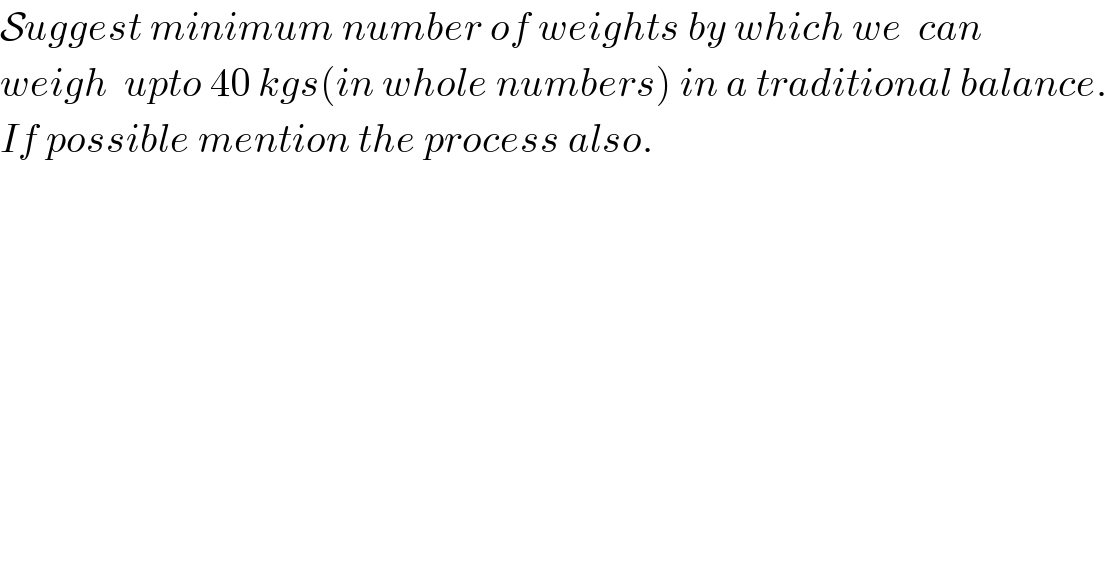
$$\mathcal{S}{uggest}\:{minimum}\:{number}\:{of}\:{weights}\:{by}\:{which}\:{we}\:\:{can}\: \\ $$$${weigh}\:\:{upto}\:\mathrm{40}\:{kgs}\left({in}\:{whole}\:{numbers}\right)\:{in}\:{a}\:{traditional}\:{balance}. \\ $$$${If}\:{possible}\:{mention}\:{the}\:{process}\:{also}. \\ $$
Commented by Rasheed Soomro last updated on 06/Dec/15

$$\mathcal{I}{n}\:{a}\:{traditional}\:{balance}\:{we}\:{can}\:{place}\:{weights}\:{on}\:{both} \\ $$$${sides}. \\ $$
Answered by prakash jain last updated on 06/Dec/15
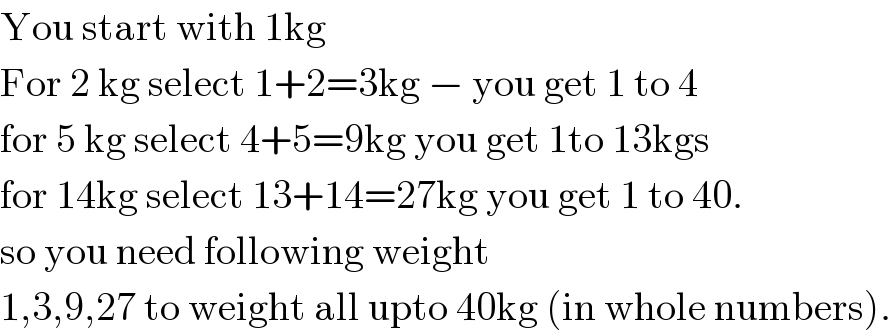
$$\mathrm{You}\:\mathrm{start}\:\mathrm{with}\:\mathrm{1kg} \\ $$$$\mathrm{For}\:\mathrm{2}\:\mathrm{kg}\:\mathrm{select}\:\mathrm{1}+\mathrm{2}=\mathrm{3kg}\:−\:\mathrm{you}\:\mathrm{get}\:\mathrm{1}\:\mathrm{to}\:\mathrm{4} \\ $$$$\mathrm{for}\:\mathrm{5}\:\mathrm{kg}\:\mathrm{select}\:\mathrm{4}+\mathrm{5}=\mathrm{9kg}\:\mathrm{you}\:\mathrm{get}\:\mathrm{1to}\:\mathrm{13kgs} \\ $$$$\mathrm{for}\:\mathrm{14kg}\:\mathrm{select}\:\mathrm{13}+\mathrm{14}=\mathrm{27kg}\:\mathrm{you}\:\mathrm{get}\:\mathrm{1}\:\mathrm{to}\:\mathrm{40}. \\ $$$$\mathrm{so}\:\mathrm{you}\:\mathrm{need}\:\mathrm{following}\:\mathrm{weight} \\ $$$$\mathrm{1},\mathrm{3},\mathrm{9},\mathrm{27}\:\mathrm{to}\:\mathrm{weight}\:\mathrm{all}\:\mathrm{upto}\:\mathrm{40kg}\:\left(\mathrm{in}\:\mathrm{whole}\:\mathrm{numbers}\right). \\ $$
Commented by RasheedAhmad last updated on 06/Dec/15

$$\overset{\mathcal{V}} {\mathcal{N}}{ice}\:\mathcal{S}{ir}! \\ $$
Commented by RasheedAhmad last updated on 06/Dec/15
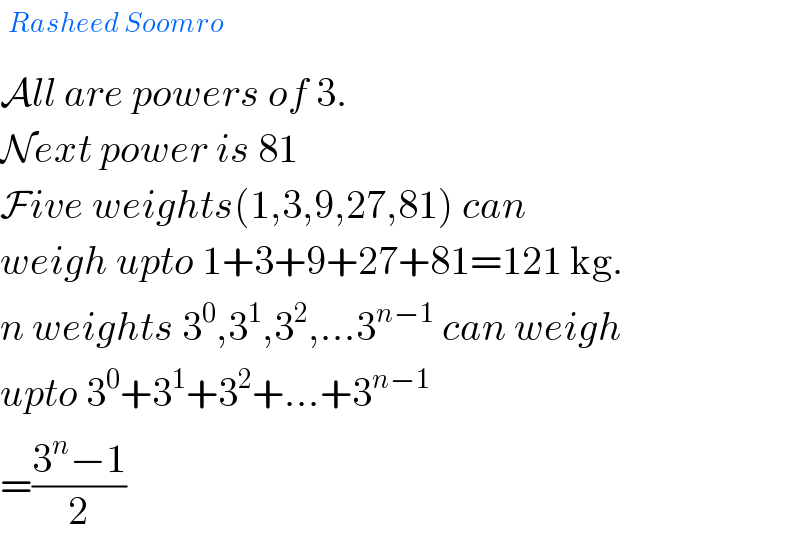
$$\:^{{Rasheed}\:{Soomro}} \\ $$$$\mathcal{A}{ll}\:{are}\:{powers}\:{of}\:\mathrm{3}. \\ $$$$\mathcal{N}{ext}\:{power}\:{is}\:\mathrm{81} \\ $$$$\mathcal{F}{ive}\:{weights}\left(\mathrm{1},\mathrm{3},\mathrm{9},\mathrm{27},\mathrm{81}\right)\:{can} \\ $$$${weigh}\:{upto}\:\mathrm{1}+\mathrm{3}+\mathrm{9}+\mathrm{27}+\mathrm{81}=\mathrm{121}\:\mathrm{kg}. \\ $$$${n}\:{weights}\:\mathrm{3}^{\mathrm{0}} ,\mathrm{3}^{\mathrm{1}} ,\mathrm{3}^{\mathrm{2}} ,...\mathrm{3}^{{n}−\mathrm{1}} \:{can}\:{weigh} \\ $$$${upto}\:\mathrm{3}^{\mathrm{0}} +\mathrm{3}^{\mathrm{1}} +\mathrm{3}^{\mathrm{2}} +...+\mathrm{3}^{{n}−\mathrm{1}} \\ $$$$=\frac{\mathrm{3}^{{n}} −\mathrm{1}}{\mathrm{2}}\: \\ $$
Commented by prakash jain last updated on 06/Dec/15

$$\mathrm{Yes}. \\ $$
Commented by Yozzi last updated on 06/Dec/15
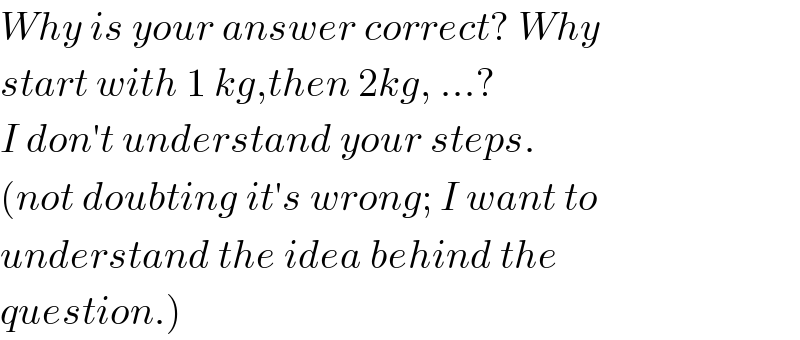
$${Why}\:{is}\:{your}\:{answer}\:{correct}?\:{Why} \\ $$$${start}\:{with}\:\mathrm{1}\:{kg},{then}\:\mathrm{2}{kg},\:...? \\ $$$${I}\:{don}'{t}\:{understand}\:{your}\:{steps}. \\ $$$$\left({not}\:{doubting}\:{it}'{s}\:{wrong};\:{I}\:{want}\:{to}\right. \\ $$$${understand}\:{the}\:{idea}\:{behind}\:{the} \\ $$$$\left.{question}.\right) \\ $$
Commented by prakash jain last updated on 06/Dec/15
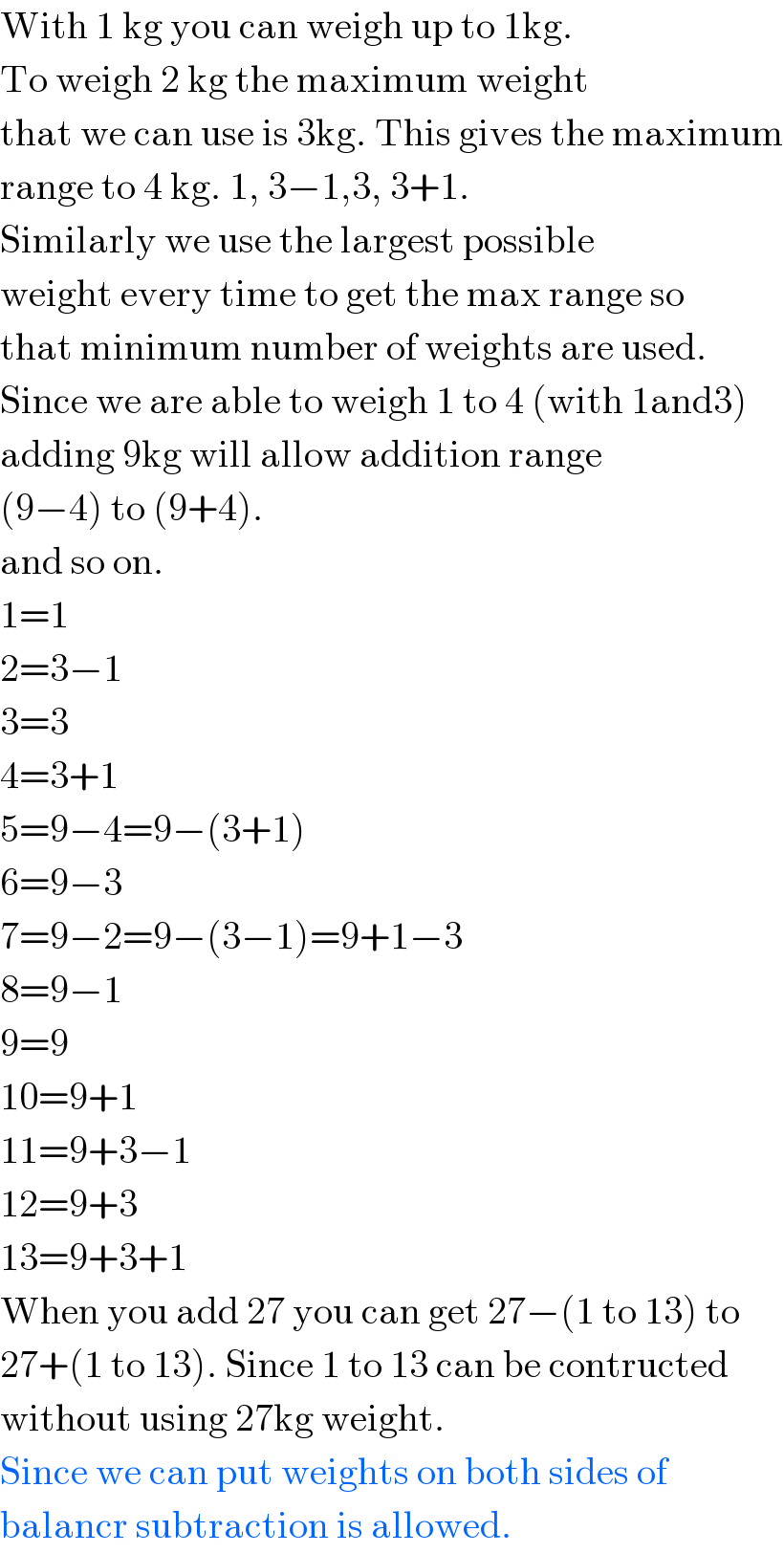
$$\mathrm{With}\:\mathrm{1}\:\mathrm{kg}\:\mathrm{you}\:\mathrm{can}\:\mathrm{weigh}\:\mathrm{up}\:\mathrm{to}\:\mathrm{1kg}. \\ $$$$\mathrm{To}\:\mathrm{weigh}\:\mathrm{2}\:\mathrm{kg}\:\mathrm{the}\:\mathrm{maximum}\:\mathrm{weight} \\ $$$$\mathrm{that}\:\mathrm{we}\:\mathrm{can}\:\mathrm{use}\:\mathrm{is}\:\mathrm{3kg}.\:\mathrm{This}\:\mathrm{gives}\:\mathrm{the}\:\mathrm{maximum} \\ $$$$\mathrm{range}\:\mathrm{to}\:\mathrm{4}\:\mathrm{kg}.\:\mathrm{1},\:\mathrm{3}−\mathrm{1},\mathrm{3},\:\mathrm{3}+\mathrm{1}. \\ $$$$\mathrm{Similarly}\:\mathrm{we}\:\mathrm{use}\:\mathrm{the}\:\mathrm{largest}\:\mathrm{possible} \\ $$$$\mathrm{weight}\:\mathrm{every}\:\mathrm{time}\:\mathrm{to}\:\mathrm{get}\:\mathrm{the}\:\mathrm{max}\:\mathrm{range}\:\mathrm{so} \\ $$$$\mathrm{that}\:\mathrm{minimum}\:\mathrm{number}\:\mathrm{of}\:\mathrm{weights}\:\mathrm{are}\:\mathrm{used}. \\ $$$$\mathrm{Since}\:\mathrm{we}\:\mathrm{are}\:\mathrm{able}\:\mathrm{to}\:\mathrm{weigh}\:\mathrm{1}\:\mathrm{to}\:\mathrm{4}\:\left(\mathrm{with}\:\mathrm{1and3}\right) \\ $$$$\mathrm{adding}\:\mathrm{9kg}\:\mathrm{will}\:\mathrm{allow}\:\mathrm{addition}\:\mathrm{range} \\ $$$$\left(\mathrm{9}−\mathrm{4}\right)\:\mathrm{to}\:\left(\mathrm{9}+\mathrm{4}\right). \\ $$$$\mathrm{and}\:\mathrm{so}\:\mathrm{on}. \\ $$$$\mathrm{1}=\mathrm{1} \\ $$$$\mathrm{2}=\mathrm{3}−\mathrm{1} \\ $$$$\mathrm{3}=\mathrm{3} \\ $$$$\mathrm{4}=\mathrm{3}+\mathrm{1} \\ $$$$\mathrm{5}=\mathrm{9}−\mathrm{4}=\mathrm{9}−\left(\mathrm{3}+\mathrm{1}\right) \\ $$$$\mathrm{6}=\mathrm{9}−\mathrm{3} \\ $$$$\mathrm{7}=\mathrm{9}−\mathrm{2}=\mathrm{9}−\left(\mathrm{3}−\mathrm{1}\right)=\mathrm{9}+\mathrm{1}−\mathrm{3} \\ $$$$\mathrm{8}=\mathrm{9}−\mathrm{1} \\ $$$$\mathrm{9}=\mathrm{9} \\ $$$$\mathrm{10}=\mathrm{9}+\mathrm{1} \\ $$$$\mathrm{11}=\mathrm{9}+\mathrm{3}−\mathrm{1} \\ $$$$\mathrm{12}=\mathrm{9}+\mathrm{3} \\ $$$$\mathrm{13}=\mathrm{9}+\mathrm{3}+\mathrm{1} \\ $$$$\mathrm{When}\:\mathrm{you}\:\mathrm{add}\:\mathrm{27}\:\mathrm{you}\:\mathrm{can}\:\mathrm{get}\:\mathrm{27}−\left(\mathrm{1}\:\mathrm{to}\:\mathrm{13}\right)\:\mathrm{to} \\ $$$$\mathrm{27}+\left(\mathrm{1}\:\mathrm{to}\:\mathrm{13}\right).\:\mathrm{Since}\:\mathrm{1}\:\mathrm{to}\:\mathrm{13}\:\mathrm{can}\:\mathrm{be}\:\mathrm{contructed} \\ $$$$\mathrm{without}\:\mathrm{using}\:\mathrm{27kg}\:\mathrm{weight}. \\ $$$$\mathrm{Since}\:\mathrm{we}\:\mathrm{can}\:\mathrm{put}\:\mathrm{weights}\:\mathrm{on}\:\mathrm{both}\:\mathrm{sides}\:\mathrm{of} \\ $$$$\mathrm{balancr}\:\mathrm{subtraction}\:\mathrm{is}\:\mathrm{allowed}. \\ $$
Commented by prakash jain last updated on 07/Dec/15
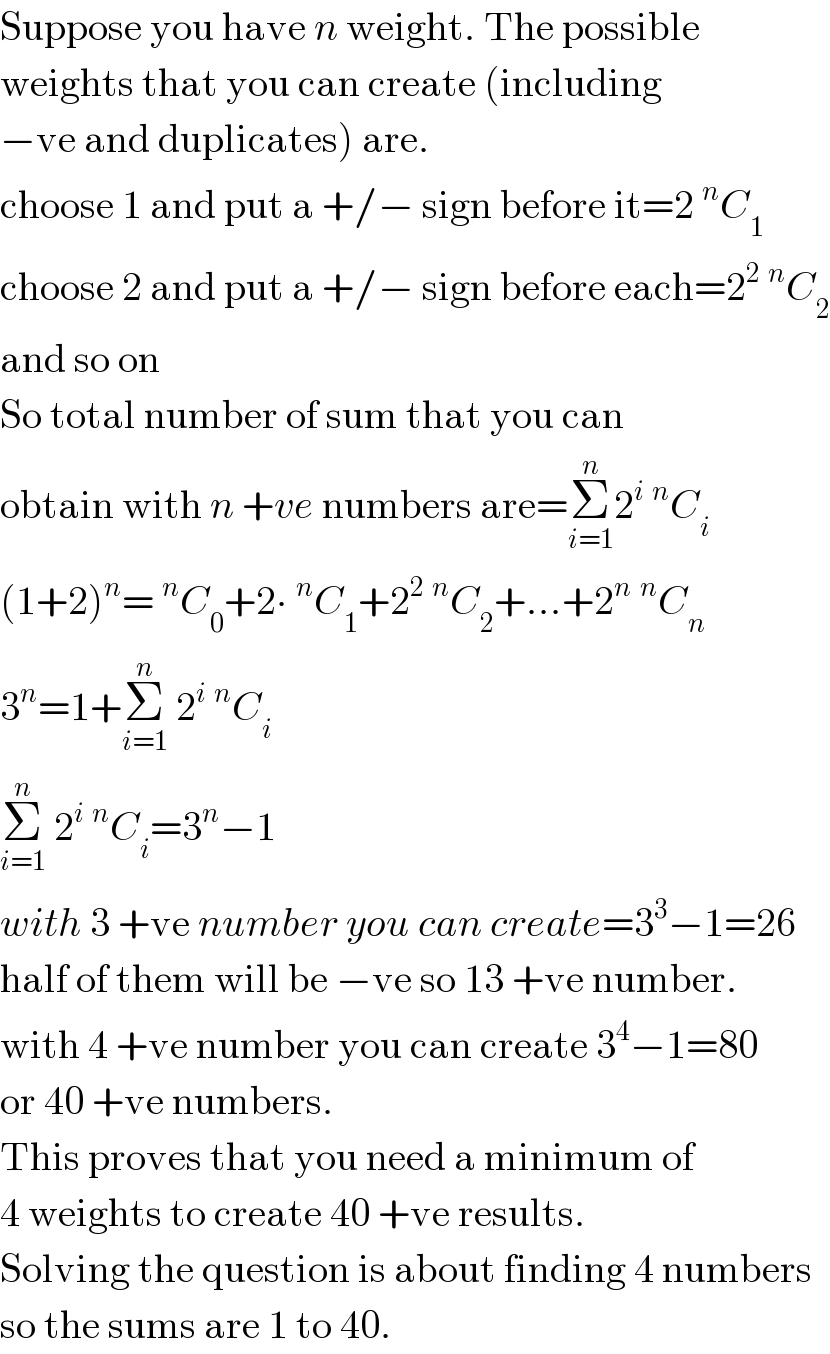
$$\mathrm{Suppose}\:\mathrm{you}\:\mathrm{have}\:{n}\:\mathrm{weight}.\:\mathrm{The}\:\mathrm{possible} \\ $$$$\mathrm{weights}\:\mathrm{that}\:\mathrm{you}\:\mathrm{can}\:\mathrm{create}\:\left(\mathrm{including}\right. \\ $$$$\left.−\mathrm{ve}\:\mathrm{and}\:\mathrm{duplicates}\right)\:\mathrm{are}. \\ $$$$\mathrm{choose}\:\mathrm{1}\:\mathrm{and}\:\mathrm{put}\:\mathrm{a}\:+/−\:\mathrm{sign}\:\mathrm{before}\:\mathrm{it}=\mathrm{2}\:^{{n}} {C}_{\mathrm{1}} \\ $$$$\mathrm{choose}\:\mathrm{2}\:\mathrm{and}\:\mathrm{put}\:\mathrm{a}\:+/−\:\mathrm{sign}\:\mathrm{before}\:\mathrm{each}=\mathrm{2}^{\mathrm{2}} \:^{{n}} {C}_{\mathrm{2}} \\ $$$$\mathrm{and}\:\mathrm{so}\:\mathrm{on}\: \\ $$$$\mathrm{So}\:\mathrm{total}\:\mathrm{number}\:\mathrm{of}\:\mathrm{sum}\:\mathrm{that}\:\mathrm{you}\:\mathrm{can} \\ $$$$\mathrm{obtain}\:\mathrm{with}\:{n}\:+{ve}\:\mathrm{numbers}\:\mathrm{are}=\underset{{i}=\mathrm{1}} {\overset{{n}} {\sum}}\mathrm{2}^{{i}} \:^{{n}} {C}_{{i}} \\ $$$$\left(\mathrm{1}+\mathrm{2}\right)^{{n}} =\:^{{n}} {C}_{\mathrm{0}} +\mathrm{2}\centerdot\:^{{n}} {C}_{\mathrm{1}} +\mathrm{2}^{\mathrm{2}} \:^{{n}} {C}_{\mathrm{2}} +...+\mathrm{2}^{{n}} \:^{{n}} {C}_{{n}} \\ $$$$\mathrm{3}^{{n}} =\mathrm{1}+\underset{{i}=\mathrm{1}} {\overset{{n}} {\sum}}\:\mathrm{2}^{{i}} \:^{{n}} {C}_{{i}} \\ $$$$\underset{{i}=\mathrm{1}} {\overset{{n}} {\sum}}\:\mathrm{2}^{{i}} \:^{{n}} {C}_{{i}} =\mathrm{3}^{{n}} −\mathrm{1} \\ $$$${with}\:\mathrm{3}\:+\mathrm{ve}\:{number}\:{you}\:{can}\:{create}=\mathrm{3}^{\mathrm{3}} −\mathrm{1}=\mathrm{26}\: \\ $$$$\mathrm{half}\:\mathrm{of}\:\mathrm{them}\:\mathrm{will}\:\mathrm{be}\:−\mathrm{ve}\:\mathrm{so}\:\mathrm{13}\:+\mathrm{ve}\:\mathrm{number}. \\ $$$$\mathrm{with}\:\mathrm{4}\:+\mathrm{ve}\:\mathrm{number}\:\mathrm{you}\:\mathrm{can}\:\mathrm{create}\:\mathrm{3}^{\mathrm{4}} −\mathrm{1}=\mathrm{80} \\ $$$$\mathrm{or}\:\mathrm{40}\:+\mathrm{ve}\:\mathrm{numbers}. \\ $$$$\mathrm{This}\:\mathrm{proves}\:\mathrm{that}\:\mathrm{you}\:\mathrm{need}\:\mathrm{a}\:\mathrm{minimum}\:\mathrm{of} \\ $$$$\mathrm{4}\:\mathrm{weights}\:\mathrm{to}\:\mathrm{create}\:\mathrm{40}\:+\mathrm{ve}\:\mathrm{results}. \\ $$$$\mathrm{Solving}\:\mathrm{the}\:\mathrm{question}\:\mathrm{is}\:\mathrm{about}\:\mathrm{finding}\:\mathrm{4}\:\mathrm{numbers} \\ $$$$\mathrm{so}\:\mathrm{the}\:\mathrm{sums}\:\mathrm{are}\:\mathrm{1}\:\mathrm{to}\:\mathrm{40}. \\ $$
Commented by Yozzi last updated on 06/Dec/15

$${Ah},\:{I}\:{now}\:{understand}.\:{It}'{s}\:{the}\:{thought} \\ $$$${behind}\:{it}\:{that}\:{I}\:{wanted}\:{to}\:{grasp}.\: \\ $$
